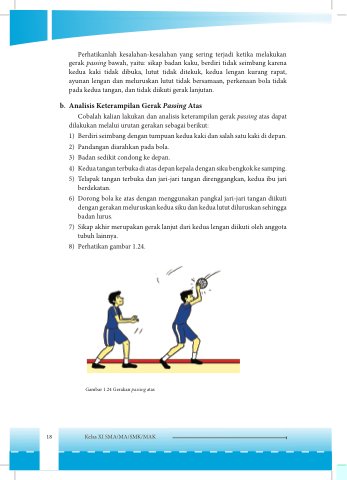Mistakes in executing the underhand pass can hinder a player’s performance in volleyball, but knowing the common pitfalls can make a difference. Berikut ini kesalahan-kesalahan yang sering terjadi ketika melakukan gerak passing bawah adalah crucial for players aiming to improve their skills. Players often neglect their footwork, leading to poor positioning and ineffective passes.
Additionally, many forget to keep their eyes on the ball, which results in misjudgments and errors. By being aware of these frequent mistakes, athletes can refine their technique and boost their confidence on the court.
Berikut Ini Kesalahan-Kesalahan yang Sering Terjadi Ketika Melakukan Gerak Passing Bawah Adalah
When it comes to sports, mastering the fundamentals is crucial for success. In volleyball, one of the essential skills players need to develop is the underhand passing technique. This skill is not just about moving the hands but also requires the right body positioning, timing, and approach. Unfortunately, many players make common mistakes when performing this technique. Understanding these errors can help players improve their passing skills and enhance their overall gameplay. In this article, we will explore the typical mistakes that occur during the underhand passing motion and how to avoid them.
Understanding the Underhand Pass
Before diving into the common mistakes, it’s important to grasp what an underhand pass is. This technique involves using the forearms to receive the ball when it is coming toward you, typically at a lower height.
To execute a proper underhand pass, follow these basic steps:
1. **Positioning**: Stand with your feet shoulder-width apart and knees slightly bent.
2. **Hand Placement**: Position your hands one on top of the other, creating a flat surface using your forearms.
3. **Body Movement**: Bend your knees and lower your body as the ball approaches.
4. **Contact**: Make contact with the ball using your forearms, directing it toward your target.
Common Mistakes in Underhand Passing
Now, let’s delve into some of the most frequent mistakes players make during the underhand passing technique.
Poor Foot Positioning
One common mistake is improper foot positioning. Players often stand too far from the target, making it difficult to reach the ball effectively.
**Avoiding Poor Foot Positioning:**
– Stay light on your feet and be ready to move.
– Position your feet directly under your hips.
– When the ball approaches, shuffle your feet to ensure you are in the best position to receive it.
Incorrect Hand Placement
Another key error is incorrect hand placement. Some players may cup their hands or keep them too close together, which can lead to inconsistent contact with the ball.
**Tips for Correct Hand Placement:**
– Always keep your hands in a fist or flat position, one on top of the other.
– Ensure your thumbs are parallel and pointing towards your target.
Failure to Bend Knees
Many players neglect to bend their knees, which affects their ability to lower their body and get into the correct position. This results in weak passes or misdirected balls.
**Improving Knee Bending:**
– Always keep your knees slightly bent and stay low when you’re anticipating the ball.
– Practice drills that emphasize knee bending for reception.
Rushing the Pass
When players feel rushed, they often lose focus on their technique. This rush leads to poor execution and inconsistent passes.
**How to Avoid Rushing:**
– Focus on staying calm and composed when preparing to receive.
– Take deep breaths and remind yourself of the basic passing techniques before the play.
Ball Watching
Players sometimes become too focused on watching the ball and forget to engage their bodies. This lack of movement can result in miscommunication among teammates.
**Tips to Avoid Ball Watching:**
– Maintain awareness of your surroundings and position your body to make the play.
– Practice peripheral awareness drills that encourage team communication.
The Importance of Follow-Through
One critical aspect that many players overlook is the follow-through after making an underhand pass. The follow-through is essential for accuracy and control.
Understanding Follow-Through
The follow-through involves the motion you make after hitting the ball. A proper follow-through can help direct the ball to the intended target.
**Improving Follow-Through:**
– Ensure your arms continue in the direction of your target after contact with the ball.
– Practice making smooth and controlled movements to develop a consistent follow-through.
Practice Drills to Fix Common Mistakes
Addressing these mistakes requires practice and dedication. Below are some drills to help players improve their underhand passing skills:
Partner Passing Drill
In this drill, players can practice their passing techniques with a partner.
– Stand about 10 feet apart.
– One player tosses the ball underhand while the other practices receiving it.
– Focus on proper foot positioning, hand placement, and follow-through.
Wall Pass Drill
This drill allows players to practice passing even when they do not have a partner.
– Stand a few feet away from a wall.
– Toss the ball underhand against the wall and practice receiving it as it rebounds.
– Emphasize maintaining the right posture and technique.
Target Passing Drill
This drill incorporates target practice for passing accuracy.
– Set up cones or targets at various distances.
– Have a partner toss the ball to you, aiming for the targets as you practice passing.
– Make adjustments to your stance, hand placement, and follow-through based on where the ball lands.
Reinforcing Good Habits
Consistent practice helps reinforce good habits in passing techniques. Here’s how players can maintain their skills:
Visualizing Success
Before each practice or game, take a moment to visualize successful underhand passes. Visualization can significantly improve performance by enhancing focus and building confidence.
Regular Feedback
Seek feedback from coaches or experienced players. Constructive criticism helps in identifying areas of improvement.
Self-Assessment
After each practice session, assess your performance. Consider factors like positioning, technique, and accuracy. Keeping a journal can help track progress.
Consistency in Practice
Make underhand passing a regular part of your practice sessions. The more you practice, the more improvement you will see in your skills.
In conclusion, mastering the underhand pass is crucial for any volleyball player. By understanding and correcting common mistakes, players can improve their passing technique and overall game performance. Focus on proper foot positioning, hand placement, knee bending, maintaining a calm demeanor, and ensuring a smooth follow-through. Through consistent practice and targeted drills, players can develop solid skills and become more effective on the court. Keep practicing and striving for improvement to enjoy a more successful volleyball experience.
kesalahan kesalahan yang sering terjadi pada blok bola voli | Wandi Satria Pratama_I1E020003
Frequently Asked Questions
What are some common mistakes to avoid when performing a low passing movement?
Many athletes frequently fail to bend their knees adequately, which can lead to a loss of balance during the pass. Additionally, players often neglect to follow through after the pass, resulting in an inaccurate throw. It’s essential to maintain a low body position, use proper hand placement on the ball, and ensure you keep your eyes on the target throughout the motion.
How can poor foot positioning affect low passing technique?
Poor foot positioning can significantly hinder the effectiveness of a low pass. Players often position their feet too far apart or too close together, which can disrupt their stability and control. Proper foot placement should involve a shoulder-width stance, allowing for better weight transfer and balance during the pass. Keeping the feet aligned with the intended target improves accuracy and power.
Why is body posture important during a low passing movement?
Body posture plays a crucial role in executing an effective low pass. Many players tend to lean too far forward or backward, which compromises their balance and coordination. Maintaining a straight back with a slight forward lean helps in generating force and keeping the passing motion stable. Proper posture supports a fluid motion and aids in delivering a consistent and accurate pass.
What impact does improper grip on the ball have when passing?
Improper grip on the ball can lead to a lack of control and accuracy in passing. Players often grip the ball too tightly or too loosely, which can cause deviations in the pass’s trajectory. It’s important to develop a comfortable grip where the fingers spread evenly around the ball, allowing for better control and a more precise release. This aspect directly affects the speed and spin of the pass.
How does focusing on the target influence passing accuracy?
Failing to focus on the target can lead to significant inaccuracies in passing. Players often get distracted or look elsewhere while passing, causing them to misjudge the distance and direction. Concentrating on the target right before and during the pass allows players to align their body and arm correctly, enhancing the chances of a successful pass. Practicing target visualization can also improve overall performance.
Final Thoughts
Berikut ini kesalahan-kesalahan yang sering terjadi ketika melakukan gerak passing bawah adalah kurangnya posisi tubuh yang tepat. Banyak pemain tidak membungkuk dengan baik, mengakibatkan passing yang tidak akurat.
Kesalahan lainnya adalah penggunaan tangan yang salah. Beberapa pemain cenderung terlalu kaku atau tidak mengikuti gerakan dengan benar, sehingga mengurangi efektivitas passing bawah.
Terakhir, perhatian pada bola juga sering diabaikan. Pemain perlu fokus penuh untuk menjaga konsentrasi dan memastikan bola berada dalam jangkauan yang tepat. Menghindari kesalahan-kesalahan ini akan meningkatkan kemampuan passing bawah secara signifikan.






